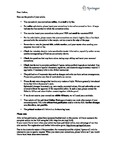3D surface topography and reflectivity of anisotropic etched silicon micromirrors for BioMEMS
| dc.contributor.author | Mackay, RE | |
| dc.contributor.author | Lionis, N | |
| dc.contributor.author | Le, HR | |
| dc.date.accessioned | 2015-02-23T11:21:53Z | |
| dc.date.available | 2015-02-23T11:21:53Z | |
| dc.date.issued | 2011-12-01 | |
| dc.identifier.issn | 0946-7076 | |
| dc.identifier.issn | 1432-1858 | |
| dc.identifier.uri | http://hdl.handle.net/10026.1/3257 | |
| dc.description | This paper was an outcome of a PhD project funded by EPSRC CASE studentship. The paper presented the design, fabrication and simulation of silicon micromirrors for force sensing in BioMEMS. An innovative direct reflectivity test method was reported. The underlying science of crystallographic etching was clearly presented. The micro fabrication and test methodologies described in this paper were valid for a wide range of microsystems that require flexural force sensing function and will benefit microsystem designers, manufacturers and end users. The journal is a fairly new journal but is becoming an important journal in the field with leading experts on the editorial board. | |
| dc.description.abstract |
This paper examines wet and dry fabrication of vertical micro-mirrors in (110) silicon for use in an innovative BioMEMS integrating gripping and micro force sensing functionalities. Wet anisotropic chemical etching in potassium hydroxide (KOH) and tetramethyl ammonium hydroxide (TMAH) with and without isopropanol alcohol (IPA) additive was examined. Deep Reactive Ion Etched samples were produced using inductive coupled process. 3D surface roughness of samples was examined using scanning electron microscope, interferometric profilometer and atomic force microscopy. An optic fiber displacement sensor was exploited to measure the reflectivity of uncoated or coated samples with evaporated metallic thin film. The research aimed to find optimal fabrication technique for fabricating vertical micro-mirrors in polymer based BioMEMS. TMAH etched silicon samples with surface roughness R a = 15.1 nm showed highest reflectivity of all structures fabricated, reflectivity was more than doubled by adding a 10 nm layer of evaporated aluminum coating. | |
| dc.format.extent | 1763-1770 | |
| dc.language | en | |
| dc.language.iso | en | |
| dc.publisher | Springer Science and Business Media LLC | |
| dc.subject | 40 Engineering | |
| dc.subject | 4016 Materials Engineering | |
| dc.subject | 4018 Nanotechnology | |
| dc.title | 3D surface topography and reflectivity of anisotropic etched silicon micromirrors for BioMEMS | |
| dc.type | journal-article | |
| dc.type | Article | |
| plymouth.author-url | http://gateway.webofknowledge.com/gateway/Gateway.cgi?GWVersion=2&SrcApp=PARTNER_APP&SrcAuth=LinksAMR&KeyUT=000297161300009&DestLinkType=FullRecord&DestApp=ALL_WOS&UsrCustomerID=11bb513d99f797142bcfeffcc58ea008 | |
| plymouth.issue | 12 | |
| plymouth.volume | 17 | |
| plymouth.publication-status | Published | |
| plymouth.journal | MICROSYSTEM TECHNOLOGIES-MICRO-AND NANOSYSTEMS-INFORMATION STORAGE AND PROCESSING SYSTEMS | |
| dc.identifier.doi | 10.1007/s00542-011-1362-3 | |
| plymouth.organisational-group | /Plymouth | |
| plymouth.organisational-group | /Plymouth/Research Groups | |
| plymouth.organisational-group | /Plymouth/Research Groups/Marine Institute | |
| dcterms.dateAccepted | 2011-09-28 | |
| dc.identifier.eissn | 1432-1858 | |
| dc.rights.embargoperiod | Not known | |
| rioxxterms.versionofrecord | 10.1007/s00542-011-1362-3 | |
| rioxxterms.licenseref.uri | http://www.rioxx.net/licenses/all-rights-reserved | |
| rioxxterms.type | Journal Article/Review |


